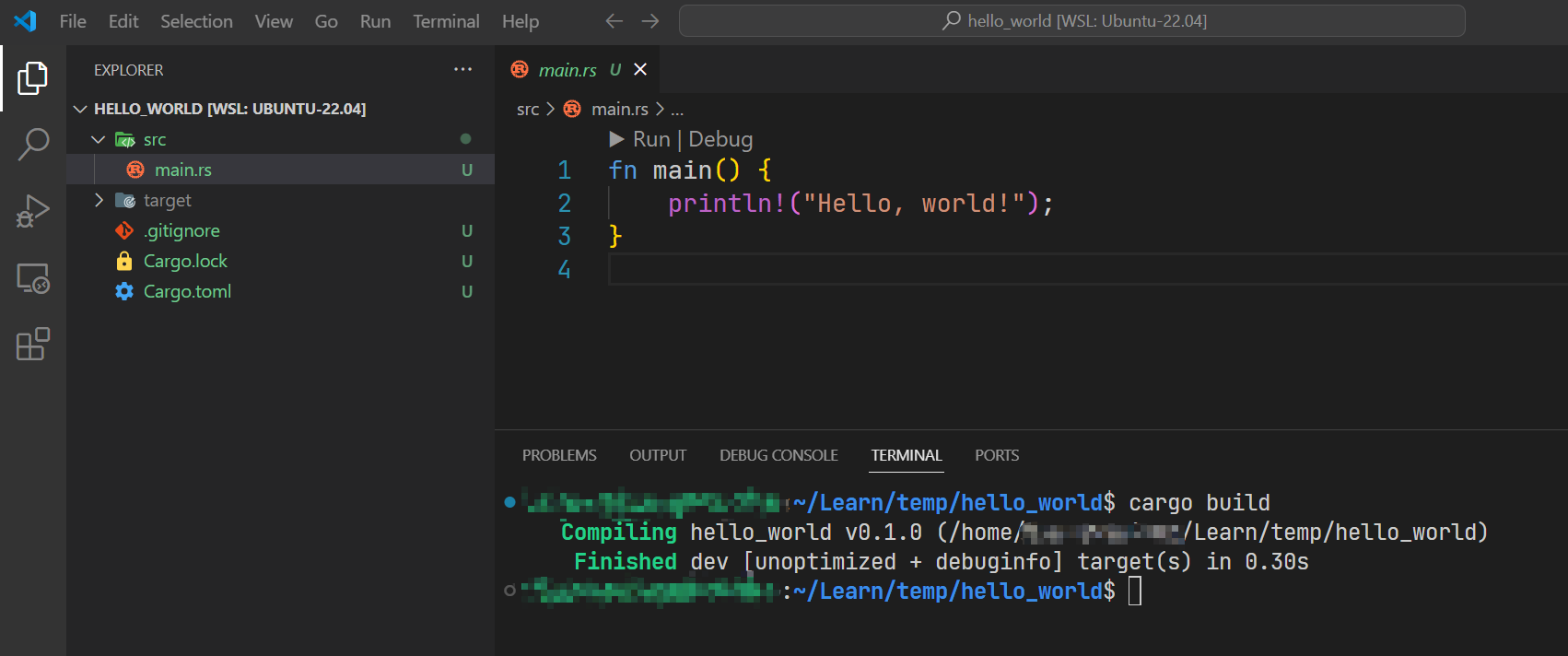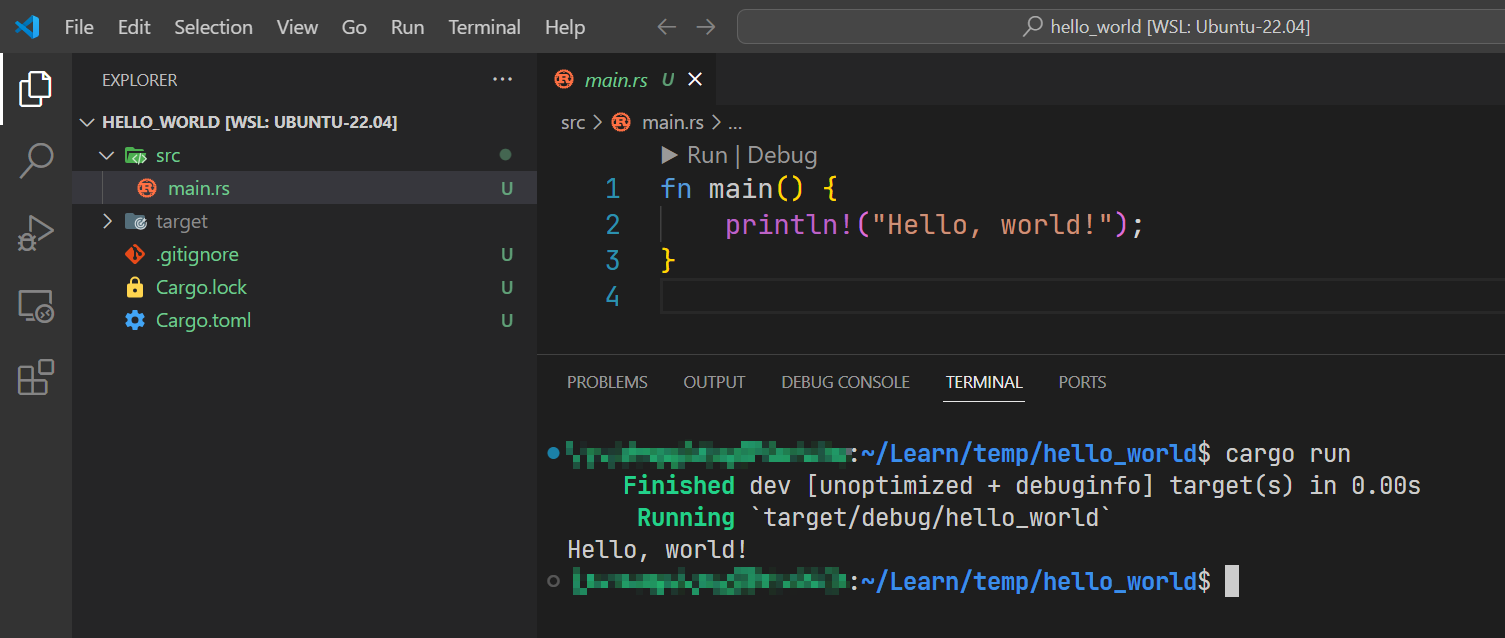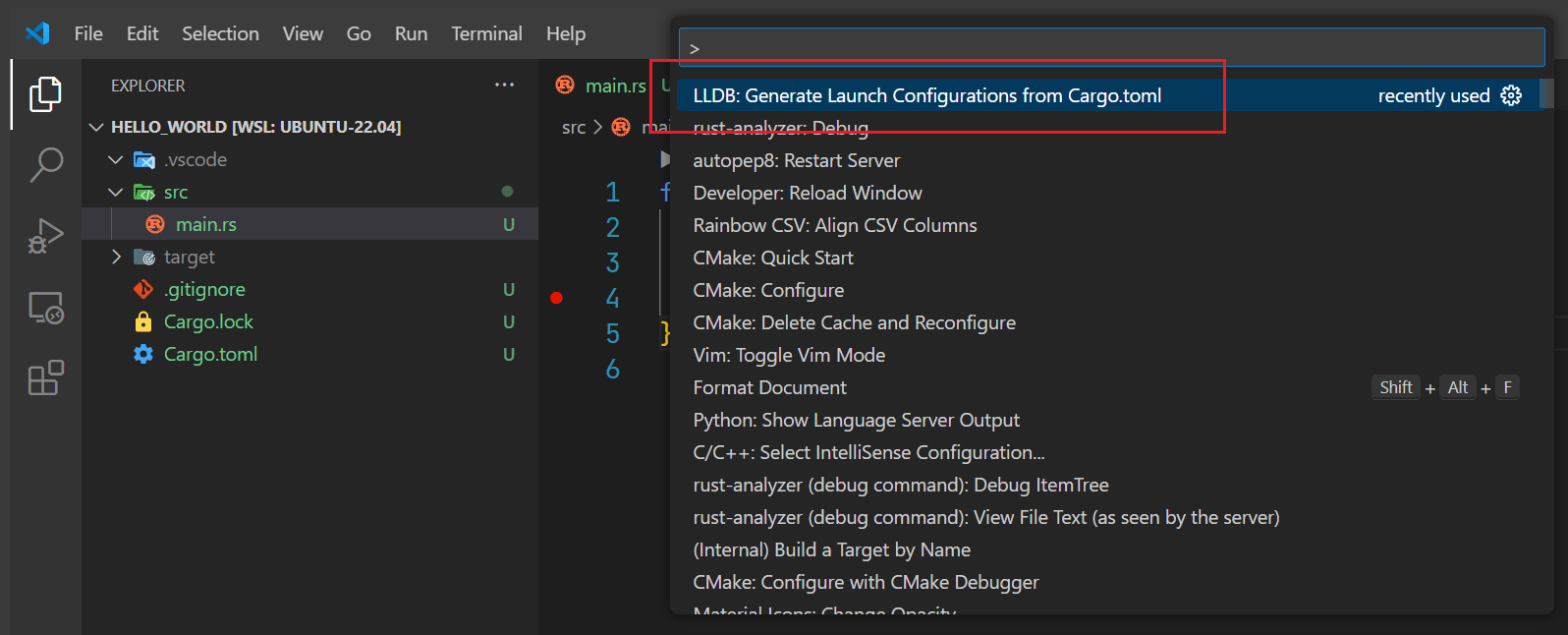- 1Vue响应式原理(源码)_vue数组响应式源码
- 2Mac VirtualBox 宿主机和虚拟机无法共享粘贴板_macos vmware windows 粘贴板
- 3算法——贪心法——多机调度问题_算法设计实验多机调度代码
- 4Android Studio汉化(中文支持)_android studio汉化包
- 5项目启动报错Unable to open debugger port(127.0.0.1:60157):java.net.SocketException“socket closed_项目已启动就报错java.net.socketexception: socket closed
- 6ArkUI页面首次创建流程介绍(3.0版本)_arkui教程
- 7基于Android的大学生社团管理APP的设计与实现
- 8python数据分析与挖掘pdf_python数据分析与挖掘实战
- 9Appium输入及模拟手势——自动化测试之路_python + appium 模拟触碰输入
- 10鸿蒙常用三方库地址一览_鸿蒙第三方库地址
[Rust] 使用vscode实现HelloWorld程序并进行debug
赞
踩
一、简介
本文介绍了如何使用vscode编写rust,实现打印"Hello, world!"的程序。
二、工具安装
0. 环境介绍:
Linux (或者windows+wsl)
1. 安装rust编译器rustc和包管理器cargo。
请参考连接:Rust 程序设计语言 简体中文版-安装。
rust编译器安装完成后,会自动安装cargo。cargo是Rust的包管理器,可以用来方便的进行包管理、编译运行rust程序。
可以使用以下命令查看是否成功安装rust编译器和cargo。
shell rustc -V
shell cargo -V
2. vscode插件安装:
安装rust-analyzer和CodeLLDB(用于debug)。
三、实现helloworld
接下来将使用cargo进行管理我们的程序(尽管程序只打印“Hello, world!”一句话)。
1. 新建hello_world工程
cargo new hello_world
- 1
此时目录下自动生成一个名字为hello_world/的文件夹。
2. 使用vscode打开工程目录文件夹
使用vscode打开hello_world/文件夹,文件结构如下。

3. 编写main.rs文件
编辑main.rs文件,main.rs文件如下:
fn main() {
println!("Hello, world!");
}
- 1
- 2
- 3
4. 编译程序
编译我们的hello_world工程。在hello_world/目录下运行以下命令。
cargo build
- 1
输出结果如下所示:

编译器的输出表示程序hello_world已经编译成功,耗时0.30s。
5. 运行程序
使用以下命令运行程序。
cargo run
- 1
若运行成功,运行结果如下:

可以看到程序成功输出了Hello, world!字符。
6. 进行debug
在vscode中对rust程序进行debug需要安装前面提到的CodeLLDB插件。首先在vscode的设置中设置Debug: Allow Breakpoints Everywhere。如下所示:

将main.rs文件内的代码修改为如下:
fn main() {
let _a = 3.0;
let _b = _a * _a;
println!("_b:{}", _b);
}
- 1
- 2
- 3
- 4
- 5
假设我们在第4行处打断点,如下图所示:

然后使用LLDB生成launch.json文件。按下ctrl+shift+p,打开vscode的命令输出栏目,输入 LLDB: Generate launch Configurations from Cargo.toml如下图所示:

按下回车后LLDB会根据Cargo.toml文件自动生成launch.json文件内容,此时文件名还是Untitled-1。我们需要将改文件保存到.vscode/目录下,并命名为launch.json(如果没有.vscode/文件夹,先手动在hello_world/目录下创建.vscode/文件夹)。LLDB自动生成的launch.json文件内容如下:
{ "version": "0.2.0", "configurations": [ { "type": "lldb", "request": "launch", "name": "Debug executable 'hello_world'", "cargo": { "args": [ "build", "--bin=hello_world", "--package=hello_world" ], "filter": { "name": "hello_world", "kind": "bin" } }, "args": [], "cwd": "${workspaceFolder}" }, { "type": "lldb", "request": "launch", "name": "Debug unit tests in executable 'hello_world'", "cargo": { "args": [ "test", "--no-run", "--bin=hello_world", "--package=hello_world" ], "filter": { "name": "hello_world", "kind": "bin" } }, "args": [], "cwd": "${workspaceFolder}" } ] }
- 1
- 2
- 3
- 4
- 5
- 6
- 7
- 8
- 9
- 10
- 11
- 12
- 13
- 14
- 15
- 16
- 17
- 18
- 19
- 20
- 21
- 22
- 23
- 24
- 25
- 26
- 27
- 28
- 29
- 30
- 31
- 32
- 33
- 34
- 35
- 36
- 37
- 38
- 39
- 40
- 41
- 42
现在hello_world/目录下的文件结构如下:

之后点击vscode的状态栏的Debug excutabel 'hello_world' (hello_world)图标,并选择Debug executable 'hello_world'即可进行debug。
即下图红框中的图标:

可以看到程序成功运行到我们的断点处,并在左侧窗口中显示了中间变量的值。如下图所示:

四、参考
[1]. Rust in Visual Studio Code
[2]. Hello, Cargo!




